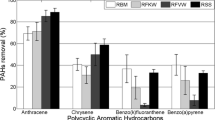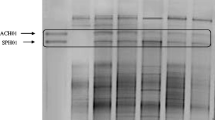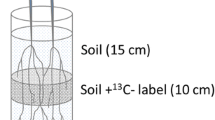Abstract
Two commercially available aerobic bioremediation methods (Daramend® and BioSan) were utilized to study the aerobic biodegradation of polycyclic aromatic hydrocarbons (PAH) and the effect of the simultaneously present arsenic. The soil was collected at an old wood preservation site, and the initial PAH16-concentration was 46 mg/kg, with mainly high molecular weight congeners. The As concentration was 105 mg/kg with low availability as assessed with sequential extraction. To enhance the availability of PAH, the effect of a nonionic surfactant was evaluated. Degradation of both low and high molecular weight PAH was observed; however, after 30 weeks, the degradation was generally low and no treatment was significantly better than the others. The treatments had, on the other hand, an effect on As remobilization, with increased As concentration in the available fraction after treatment. This may be due to both the microbial activity and the presence of anoxic microsites in the soil. The overall efficiency of the biological treatment was further evaluated using the standardized ecotoxicity test utilizing Vibrio fischeri (Microtox®). The toxicity test demonstrated that the bioremediation led to an increase in toxicity, especially in treatments receiving surfactant. The surfactant implied an increase in contaminant availability but also a decrease in surface tension, which might have contributed to the overall toxicity increase.



Similar content being viewed by others
References
Alexander, M. (1999). Biodegradation and bioremediation. San Diego: Academic.
Andersson, E., Rotander, A., von Kronhelm, T., Berggren, A., Ivarsson, P., Hollert, H., et al. (2009). AhR antagonist and genotoxicant bioavailability in a PAH-contaminated soil undergoing biological treatment. Environmental Science and Pollution Research, 16(5), 521–530.
Antizar-Ladislao, B., Lopez-Real, J., & Beck, A. J. (2005). Laboratory studies of the remediation of polycyclic aromatic hydrocarbon contaminated soil by in-vessel composting. Waste Management, 25(3), 281–289.
Ascar, L., Ahumada, I., & Richter, P. (2008). Influence of redox potential (Eh) on the availability of arsenic species in soils and soils amended with biosolid. Chemosphere, 72(10), 1548–1552.
Atagana, H. I., Haynes, R. J., & Wallis, F. M. (2003). Optimization of soil physical and chemical conditions for the bioremediation of creosote-contaminated soil. Biodegradation, 14(4), 297–307.
Bhattacharya, P., Mukherjee, A. B., Jacks, G., & Nordqvist, S. (2002). Metal contamination at wood preservation site: characterization and experimental studies on remediation. The Science of the Total Environment, 290(1–3), 165–180.
Bhattacharya, P., Welch, A. H., Stollenwerk, K. G., McLaughlin, M. J., Bundschuh, J., & Panaullah, G. (2007). Arsenic in the environment: biology and chemistry. The Science of the Total Environment, 379(2–3), 109–120.
Chang, B. V., Shiung, L. C., & Yuan, S. Y. (2002). Anaerobic biodegradation of polycyclic aromatic hydrocarbon in soil. Chemosphere, 48(7), 717–724.
Eom, I. C., Rast, C., Veber, A. M., & Vasseur, P. (2007). Ecotoxicity o a polycyclic aromatic hydrocarbon (PAH)-contaminated soil. Ecotoxicology and Environmental Safety, 67(2), 190–205.
Frankenberger, W. T., Jr. (2002). Environmental chemistry of arsenic. New York: Marcel Dekker, Inc.
Fulladosa, E., Murat, J.-C., Martínez, M., & Villaescusa, I. (2005). Patterns of metals and arsenic poisoning in Vibrio fischeri bacteria. Chemosphere, 60(1), 43–48.
Fulladosa, E., Debord, J., Villaescusa, I., Bollinger, J.-C., & Murat, J.-C. (2007). Effect of arsenic compounds on Vibrio fischeri light emission and butyrylcholinesterase activity. Environmental Chemistry Letters, 5(3), 115–119.
Henke, K. R. (2009). Arsenic: Environmental chemistry, health threats and waste treatment. Chichester, U.K.: Wiley.
Inskeep, W. P., McDermott, T. R., & Fendorf, S. (2002). Arsenic (V)/(III) cycling in soils and natural waters: chemical and microbiological processes. In J. Frankenberger & T. William (Eds.), Environmental chemistry of arsenic. New York: Marcel Dekker, Inc.
Johnsen, A. R., Wick, L. Y., & Harms, H. (2005). Principles of microbial PAH-degradation in soil. Environmental Pollution, 133(1), 71–84.
Juhasz, A. L., & Naidu, R. (2000). Bioremediation of high molecular weight polycyclic aromatic hydrocarbons: a review of the microbial degradation of benzo[a]pyrene. International Biodeterioration & Biodegradation, 45(1–2), 57–88.
Korda, A., Santas, P., Tenente, A., & Santas, R. (1997). Petroleum hydrocarbon bioremediation: sampling and analytical techniques, in situ treatments and commercial microorganisms currently used. Applied Microbiology & Biotechnology, 48(6), 677–686.
Lee, J.-U., Lee, S.-W., Chon, H.-T., Kim, K.-W., & Lee, J. S. (2009). Enhancement of arsenic mobility by indigenous bacteria from mine tailings as response to organic supply. Environment International, 35(3), 469–501.
Liebeg, E. W., & Cutright, T. J. (1999). The investigation of enhanced bioremediation through the addition of macro and micro nutrients in a PAH-contaminated soil. International Biodeterioration & Biodegradation, 44(1), 55–64.
Loibner, A. P., Szolar, O. H. J., Braun, R., & Hirmann, D. (2004). Toxicity testing of 16 priority polycyclic aromatic hydrocarbons using Lumistox®. Environmental Toxicology and Chemistry, 23(3), 557–564.
Lundstedt, S., White, P. A., Lemieux, C. L., Lynes, K. D., Lambert, I. B., Öberg, L., et al. (2007). Sources, fate, and toxic hazards of oxygenated polycyclic aromatic hydrocarbons (PAHs) at PAH-contaminated sites. Ambio, 36(6), 475–485.
Mazidji, C. N., Koopman, B., Bitton, G., & Neita, D. (1992). Distinction between heavy metal and organic toxicity using EDTA chelation and microbial assays. Environmental Toxicology and Water Chemistry, 7(4), 339–353.
McConkey, B. J., Duxbury, C. L., Dixon, D. G., & Greenberg, B. M. (1997). Toxicity of PAH photooxidation product to the bacteria Photobacterium phosphoreum and the duckweed Lemna gibba: Effects of phenanthrene and its primary photoproduct, phenanthrenequinone. Environmental Toxicology and Chemistry, 16(5), 892–899.
Mendonça, E., & Picado, A. (2002). Ecotoxicological monitoring of remediation in a coke oven soil. Environmental Toxicology, 17(1), 74–79.
Mohammed, D., Ramsubhag, A., & Beckles, D. M. (2007). An assessment of the biodegradation of petroleum hydrocarbons in contaminated soil using non-indigenous, commercial microbes. Water, Air & Soil Pollution, 182(1), 349–356.
Mohan, S. V., Kisa, T., Ohkuma, T., Kanaly, R. A., & Shimizu, Y. (2006). Bioremediation technologies for treatment of PAH-contaminated soil and strategies to enhance process efficiency. Reviews in Environmental Science and Bio/Technology, 5(4), 347–374.
Páez-Espino, D., Tamames, J., de Lorenzo, V., & Cánovas, D. (2009). Microbial responses to environmental arsenic. Biometals, 22(1), 117–130.
Paria, S. (2008). Surfactant-enhanced remediation of organic contaminated soil and water. Advances in Colloid and Interface Science, 138(1), 24–58.
Phillips, T. M., Liu, D., Seech, A. G., Lee, H., & Trevors, J. T. (2000). Bioremediation in field box plots of a soil contaminated with wood-preservatives: a comparison of treatment conditions using toxicity testing as a monitoring technique. Water, Air & Soil Pollution, 121(1–4), 173–187.
Potter, C. L., Glaser, J. A., Chang, L., Meier, J. R., Dosani, M. A., & Herrmann, R. F. (1999). Degradation of polynuclear aromatic hydrocarbons under bench-scale compost conditions. Environmental Science & Technology, 33(10), 1717–1725.
Rhine, E. D., Garcia-Dominguez, E., Phelps, C. D., & Young, L. Y. (2005). Environmental microbes can speciate and cycle arsenic. Environmental Science & Technology, 39(24), 9569–9573.
Rhykerd, R. L., Crews, B., McInnes, K. J., & Weaver, R. W. (1999). Impact of bulking agents, forced aeration, and tillage on remediation of oil-contaminated soil. Bioresource Technology, 67(3), 279–285.
Seech, A. G., Marvan, I., & Trevors, J. T. (1994). On-site/ex situ bioremediation of industrial soils containing chlorinated phenols and polycyclic aromatic hydrocarbons. In R. E. Hinchee, A. Leeson, L. Semprini, & S.-K. Ong (Eds.), Bioremediation of chlorinated and polycyclic aromatic hydrocarbon compounds (pp. 451–455). Boca Raton: Lewis Publishers.
Sharma, H. D., & Reddy, K. R. (2004). Geoenvironmental engineering: site remediation, waste containment, and emerging waste management technologies. New Jersey: John Wiley & Sons Inc.
Sherrard, K. B., Marriott, P. J., McCormick, M. J., & Millington, K. (1996). A limitation of the Microtox® test for toxicity measurement of nonionic surfactants. Environmental Toxicology & Chemistry, 15(7), 1034–1037.
Simon, M. A., Bonner, J. S., Page, C. A., Townsend, R. T., Mueller, D. C., Fuller, C. B., et al. (2004). Evaluation of two commercial bioaugmentation products for enhanced removal of petroleum from wetland. Ecological Engineering, 22(4–5), 263–277.
Smedley, P. L., & Kinniburgh, D. G. (2002). A review of the source, behavior and distribution of arsenic in natural waters. Applied Geochemistry, 17(5), 517–568.
Sobisch, T., Hess, H., Niebelschütz, H., & Schmidt, U. (2000). Effect of additives on biodegradation of PAH in soil. Colloids and Surfaces A: Physiochemical and Engineering Aspects, 162(1–3), 1–14.
Straube, W. L., Nestler, C. C., Hansen, L. D., Ringleberg, D., Pritchard, P. H., & Jones-Meehan, J. (2003). Remediation of polyaromatic hydrocarbons (PAHs) through landfarming with biostimulation and bioaugmentation. Acta Biotechnologica, 23(2–3), 179–196.
Tessier, A., Campbell, P. G. C., & Bisson, M. (1979). Sequential extraction procedure for the speciation of particulate trace metals. Analytical Chemistry, 51(7), 844–851.
US-EPA (1996). Grace bioremediation technologies Daramend™ bioremediation technology. EPA/540/R-95/536.
US-EPA (1997). Recent developments for in situ treatment for metal contaminated soils. EPA/542/R-97/004.
Wang, S., & Zhao, X. (2009). On the potential of biological treatment for arsenic contaminated soils and groundwater. Journal of Environmental Management, 90(8), 2367–2376.
Yamamura, S., Yamamoto, N., Ike, M., & Fujita, M. (2005). Arsenic extraction from solid phase using a dissimilatory arsenate-reducing bacterium. Journal of Bioscience and Bioengineering, 100(2), 219–222.
Zheng, Z., & Obbard, J. P. (2002). Evaluation of an elevated non-ionic surfactant critical micelle concentration in a soil/aqueous system. Water Research, 36(10), 2667–2672.
Acknowledgements
This research was funded by the Knowledge Foundation. Elmer Schöbel and Linda Söderling, Sakab, are especially thanked for their help with the GC/MS. Akzo Nobel, Stenungsund, Sweden, is thanked for providing the surfactant.
Author information
Authors and Affiliations
Corresponding author
Rights and permissions
About this article
Cite this article
Elgh-Dalgren, K., Arwidsson, Z., Ribé, V. et al. Bioremediation of a Soil Industrially Contaminated by Wood Preservatives—Degradation of Polycyclic Aromatic Hydrocarbons and Monitoring of Coupled Arsenic Translocation. Water Air Soil Pollut 214, 275–285 (2011). https://doi.org/10.1007/s11270-010-0422-0
Received:
Accepted:
Published:
Issue Date:
DOI: https://doi.org/10.1007/s11270-010-0422-0




